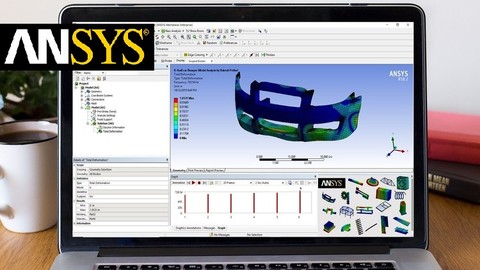
ANSYS Training: An Easy Introduction with Applications
ANSYS Training: An Easy Introduction with Applications, available at $74.99, has an average rating of 4.48, with 134 lectures, 1 quizzes, based on 2154 reviews, and has 10052 subscribers.
You will learn about Will be able to demonstrate the knowledge on applying the industry leading FEA software ( Ansys Workbench) for solving the real world engineering problems. Will Learn how to Effectively perform static structural Analysis in 3-D, 2-D & 1-D using Ansys Workbench. Will Learn how to Effectively perform Modal Analysis (Type of Dynamic Analysis) using Ansys Workbench. Will Learn how to Effectively perform Thermal Analysis using Ansys Workbench. Will Learn how to Effectively perform Thermo-structural Analysis using Ansys Workbench. Will Learn how to generate good meshes for the Finite Element Analysis. Will learn about the basics of Finite Element Analysis along with basics of Static Structural, Thermal, Modal and Coupled field analysis. Will learn to apply this Ansys Workbench software to their academic and research Projects. This course is ideal for individuals who are People who are willing to learn Ansys software. or Engineering Students who want equip themselves with industry demanding Finite Element Analysis software skills. or Designers and Engineers who want to upgrade their Skill Set. or Hobbyists who work on Mechanical design and construction projects. It is particularly useful for People who are willing to learn Ansys software. or Engineering Students who want equip themselves with industry demanding Finite Element Analysis software skills. or Designers and Engineers who want to upgrade their Skill Set. or Hobbyists who work on Mechanical design and construction projects.
Enroll now: ANSYS Training: An Easy Introduction with Applications
Summary
Title: ANSYS Training: An Easy Introduction with Applications
Price: $74.99
Average Rating: 4.48
Number of Lectures: 134
Number of Quizzes: 1
Number of Published Lectures: 132
Number of Curriculum Items: 135
Number of Published Curriculum Objects: 132
Original Price: $129.99
Quality Status: approved
Status: Live
What You Will Learn
- Will be able to demonstrate the knowledge on applying the industry leading FEA software ( Ansys Workbench) for solving the real world engineering problems.
- Will Learn how to Effectively perform static structural Analysis in 3-D, 2-D & 1-D using Ansys Workbench.
- Will Learn how to Effectively perform Modal Analysis (Type of Dynamic Analysis) using Ansys Workbench.
- Will Learn how to Effectively perform Thermal Analysis using Ansys Workbench.
- Will Learn how to Effectively perform Thermo-structural Analysis using Ansys Workbench.
- Will Learn how to generate good meshes for the Finite Element Analysis.
- Will learn about the basics of Finite Element Analysis along with basics of Static Structural, Thermal, Modal and Coupled field analysis.
- Will learn to apply this Ansys Workbench software to their academic and research Projects.
Who Should Attend
- People who are willing to learn Ansys software.
- Engineering Students who want equip themselves with industry demanding Finite Element Analysis software skills.
- Designers and Engineers who want to upgrade their Skill Set.
- Hobbyists who work on Mechanical design and construction projects.
Target Audiences
- People who are willing to learn Ansys software.
- Engineering Students who want equip themselves with industry demanding Finite Element Analysis software skills.
- Designers and Engineers who want to upgrade their Skill Set.
- Hobbyists who work on Mechanical design and construction projects.
Ansys Workbench is a general-purpose Finite Element Analysis (FEA) software that is widely used in the Industry and Academia to solve many different engineering problems through a virtual simulation of the Engineering Designs under consideration.
Ansys Workbench is applied to virtual simulate the product operating conditions and helps us to understand its behavior and helps us achieve very good design through simulation and optimization even before the product has been manufactured.
Using Ansys Workbench software we can Simulate problems from Different fields such as Structural, Vibrations, Heat transfer, Fluid Flows, and many more types.
This course is all about learning and completing the Essential training required for effective usage of the Ansys Workbench Software so that by the end of the course you will be able confidently to perform Meshing of geometries, Static Structural, Modal, Thermal, Thermo-structural, buckling analysis using this Ansys Workbench software. you will also get acquainted with the Design Modeler, Ansys Mechanical, Ansys Engineering Data, and other important modules in Ansys Workbench Software.
This course is divided into Theoretical and Practical Sessions.
In the Theoretical session, you will be introduced to the basic theoretical concepts regarding the topics of FEA, Meshing, Static Structural, Modal, Thermal, Thermo-structural, and buckling analysis.
In the Practical sessions, you will be using industrial and academic examples for learning how to apply Ansys Workbench software for efficiently performing different kinds of Simulations such as:
– Static Structural Analysis
– 3-D Static Structural Analysis
– 2-D Static Structural Analysis
– 1-D Static Structural Analysis
– Modal Analysis
– Free Vibration Analysis
– Forced Vibration Analysis (Pre-Stressed)
– Thermal Analysis
– Conduction Mode
– Convection Mode
– Radiation Mode
– Mixed Mode Heat Transfer
– Thermo-Structural Analysis
– Buckling Analysis
– Structural Buckling
– Thermal Buckling
– Contact Analysis
– Meshing with old and Newer Versions of Ansys Workbench
– Ansys Workbench Interface for Old and Newer Versions of Ansys Workbench
– Engineering data manager and Design Modeler
– FEA theory
New Sections and Examples are going to be added based on requirements whenever required…, So Stay Hungry to Learn new topics and examples.
In addition to all of these analyses, you will learn about meshing and how to generate good mesh, the use of the Design Modeler Module, and other vital modules in Ansys Workbench software.
I hope you will join me in this course to learn more about FEA analysis and Ansys Workbench software.
Course Curriculum
Chapter 1: Introduction to Finite Element Analysis
Lecture 1: Industrial Design Cycle
Lecture 2: Ways to solve engineering problems ?
Lecture 3: Different types of Numerical Techniques to solve Engineering Problems
Chapter 2: Important terms in Finite Element Method
Lecture 1: Important terms in FEM-I
Lecture 2: Important terms in FEM-II
Lecture 3: Important terms in FEM-III
Lecture 4: Strengths and weakness of FEM Techniques ?
Lecture 5: What CAE means and its relation with FEA?
Lecture 6: Applications of FEA
Chapter 3: Basics of FEA Analysis
Lecture 1: Procedure for solving a problem using any FEA software?
Lecture 2: How to perform verification and Validation of FEM Results?
Lecture 3: How does the software perform its simulation ?
Lecture 4: How does the software perform its simulation – II ?
Chapter 4: Introduction to Ansys Workbench software
Lecture 1: Introduction to Ansys Workbench Interface
Lecture 2: Unit systems in Ansys Workbench Software
Lecture 3: Saving Ansys Workbench files
Chapter 5: Interface differences b/w Ansys 18 and Latest Version
Lecture 1: Interface difference b/w Ansys 18 and Ansys 2021 r1 – I
Lecture 2: Interface difference b/w Ansys 18 and Ansys 2021 r1 – II
Lecture 3: Interface difference b/w Ansys 18 and Ansys 2021 r1 – III
Lecture 4: Interface difference b/w Ansys 18 and Ansys 2021 r1 – IV
Lecture 5: Interface difference b/w Ansys 18 and Ansys 2021 r1 – V
Lecture 6: Interface difference b/w Ansys 18 and Ansys 2021 r1 – VI
Lecture 7: Interface difference b/w Ansys 18 and Ansys 2021 r1 – VII
Lecture 8: Interface difference b/w Ansys 18 and Ansys 2021 r1 – VIII
Lecture 9: Interface difference b/w Ansys 18 and Ansys 2021 r1 – IX
Lecture 10: Interface difference b/w Ansys 18 and Ansys 2021 r1 – X
Lecture 11: Interface difference b/w Ansys 18 and Ansys 2021 r1 – XI
Lecture 12: Interface difference b/w Ansys 18 and Ansys 2021 r1 – XII
Chapter 6: Introduction to Ansys Engineering Data Manager
Lecture 1: Introduction to Ansys Engineering data manager
Lecture 2: Adding custom Material to Ansys Engineering Data
Lecture 3: Accessing Engineering Material Libraries present in Ansys workbench
Chapter 7: Introduction to Design Modeler in Ansys Workbench
Lecture 1: Introduction to Design Modeler in Ansys Workbench
Lecture 2: Using Sketching & Modelling tools in Ansys Workbench Design Modeler
Lecture 3: Revolve, Sweep and Loft tools inside Ansys workbench Design Modeler
Lecture 4: 1-D Modelling of a bicycle frame in Ansys workbench design modeler
Lecture 5: 1D+2D Hybrid body Modelling in Ansys workbench design modeler
Lecture 6: Reducing 3-D object to 2-D surface object using Ansys workbench design modeler
Chapter 8: Introduction to Ansys workbench Meshing module using Ansys V18
Lecture 1: Introduction to Theory of meshing
Lecture 2: Meshing with Global mesh controls in Ansys workbench meshing module
Lecture 3: Meshing with Local mesh controls in Ansys workbench meshing module
Lecture 4: Mesh Testing using mesh quality metrics in Ansys Workbench
Chapter 9: Introduction to Meshing for software version from 19.2 to the latest
Lecture 1: Introduction to Global meshing options
Lecture 2: Localized mesh refinement and sizing options
Lecture 3: Meshing Methods-1
Lecture 4: Meshing Methods-2
Lecture 5: Meshing Methods-3
Chapter 10: Introduction to the Static Structural Analysis theory
Lecture 1: Introduction to Static Structural Analysis Theory
Lecture 2: Introduction to Static Structural Analysis in Ansys Workbench
Chapter 11: 3-D Static Structural Analysis in Ansys Workbench
Lecture 1: Problem Description: Cantilever beam Analysis in Ansys Workbench
Lecture 2: Cantilever Beam analysis in Ansys – I
Lecture 3: Cantilever Beam analysis in Ansys – II
Lecture 4: Cantilever Beam analysis in Ansys – III
Lecture 5: Problem Description: Pneumatic Cylinder Cover Analysis in Ansys Workbench
Lecture 6: Pneumatic Cylinder cover analysis in Ansys workbench – I
Lecture 7: Pneumatic Cylinder cover analysis in Ansys Workbench – II
Lecture 8: Pneumatic Cylinder cover analysis in Ansys Workbench – III
Lecture 9: Pneumatic Cylinder cover analysis in Ansys Workbench – IV
Lecture 10: Problem Description: LED TV Stand Analysis in Ansys Workbench
Lecture 11: LED TV Stand analysis in Ansys Workbench – I
Lecture 12: LED TV Stand analysis in Ansys Workbench – II
Lecture 13: LED TV Stand analysis in Ansys Workbench – III
Lecture 14: LED TV Stand analysis in Ansys Workbench – IV
Lecture 15: Problem Description: Clevis Pin Assembly Analysis in Ansys Workbench
Lecture 16: Clevis Pin Assembly Analysis in Ansys Workbench – I
Lecture 17: Clevis Pin Assembly Analysis in Ansys Workbench – II
Lecture 18: Clevis Pin Assembly Analysis in Ansys Workbench – III
Lecture 19: Problem Description: Fly wheel Analysis in Ansys Workbench
Lecture 20: Flywheel Analysis in Ansys Workbench – I
Lecture 21: Flywheel Analysis in Ansys Workbench – II
Lecture 22: Flywheel Analysis in Ansys Workbench – III
Chapter 12: 2-D Static Structural Analysis in Ansys Workbench
Lecture 1: Problem Description: Gear & Rack Analysis in Ansys Workbench
Lecture 2: Gear & Rack Analysis in Ansys Workbench – I
Lecture 3: Gear & Rack Analysis in Ansys Workbench – II
Lecture 4: Gear & Rack Analysis in Ansys Workbench – III
Lecture 5: Gear & Rack Analysis in Ansys Workbench – IV
Lecture 6: Problem Description: Bolt & Nut Analysis in Ansys Workbench
Lecture 7: Bolt & Nut Analysis in Ansys Workbench – I
Lecture 8: Bolt & Nut Analysis in Ansys Workbench – II
Lecture 9: Problem Description: Bookshelf Analysis in Ansys Workbench
Lecture 10: Bookshelf Analysis in Ansys Workbench
Chapter 13: 1-D Static Structural Analysis in Ansys Workbench
Lecture 1: Problem Description: Planar Truss Analysis in Ansys Workbench
Lecture 2: Planar Truss Analysis in Ansys Workbench – I
Lecture 3: Planar Truss Analysis in Ansys Workbench – II
Lecture 4: Planar Truss Analysis in Ansys Workbench – III
Lecture 5: Problem Description: High rise steel frame Analysis in Ansys Workbench
Lecture 6: High rise steel frame Analysis in Ansys Workbench – I
Lecture 7: High rise steel frame Analysis in Ansys Workbench – II
Instructors
-
Rakesh Potluri
Teacher, Author, Researcher & Life Long Learner
Rating Distribution
- 1 stars: 23 votes
- 2 stars: 52 votes
- 3 stars: 315 votes
- 4 stars: 958 votes
- 5 stars: 806 votes
Frequently Asked Questions
How long do I have access to the course materials?
You can view and review the lecture materials indefinitely, like an on-demand channel.
Can I take my courses with me wherever I go?
Definitely! If you have an internet connection, courses on Udemy are available on any device at any time. If you don’t have an internet connection, some instructors also let their students download course lectures. That’s up to the instructor though, so make sure you get on their good side!
You may also like
- Best Video Editing Courses to Learn in March 2025
- Best Music Production Courses to Learn in March 2025
- Best Animation Courses to Learn in March 2025
- Best Digital Illustration Courses to Learn in March 2025
- Best Renewable Energy Courses to Learn in March 2025
- Best Sustainable Living Courses to Learn in March 2025
- Best Ethical AI Courses to Learn in March 2025
- Best Cybersecurity Fundamentals Courses to Learn in March 2025
- Best Smart Home Technology Courses to Learn in March 2025
- Best Holistic Health Courses to Learn in March 2025
- Best Nutrition And Diet Planning Courses to Learn in March 2025
- Best Yoga Instruction Courses to Learn in March 2025
- Best Stress Management Courses to Learn in March 2025
- Best Mindfulness Meditation Courses to Learn in March 2025
- Best Life Coaching Courses to Learn in March 2025
- Best Career Development Courses to Learn in March 2025
- Best Relationship Building Courses to Learn in March 2025
- Best Parenting Skills Courses to Learn in March 2025
- Best Home Improvement Courses to Learn in March 2025
- Best Gardening Courses to Learn in March 2025






















